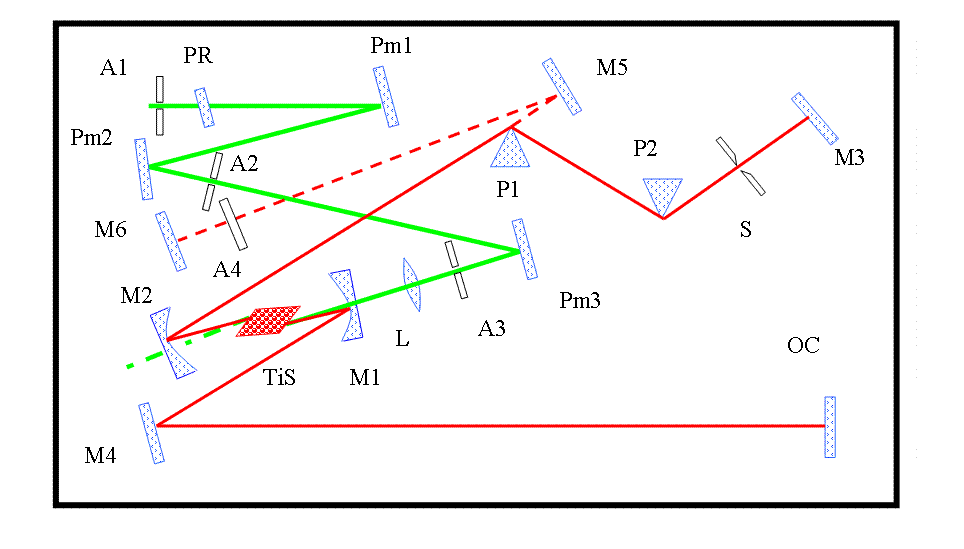
Fused silica prism in femtosecond lasers
Prismatic pulse compressors for femtosecond lasers were first
introduced in single-prism configuration by Dietel et al. Picture below shows a
schematic of Del Mar
Photonics
Trestles femtosecond Ti:Sapphire laser with a prism pair.
Del Mar Photonics offer dispersion prisms from
stock.

References:
W. Dietel et al., Intracavity pulse compression with glass: a new method of
generating pulses shorter than 60 fs, Opt. Lett. 8, 4-6 (1983).
F. J. Duarte and J. A. Piper, Dispersion theory of multiple-prism beam expander
for pulsed dye lasers, Opt. Commun. 43, 303-307 (1982).
R. L. Fork et al., Negative dispersion using pairs of prisms, Opt. Lett. 9,
150-152 (1984).
F. J. Duarte, Generalized multiple-prism dispersion theory for pulse compression
in ultrafast dye lasers, Opt. Quantum Electron. 19, 223-229 (1987).
F. J. Duarte, Prismatic pulse compression: beam deviations and geometrical
perturbations, Opt. Quantum Electron. 22, 467-471 (1990).
K. Osvay et al., Measurement of non-compensated angular dispersion and the
subsequent temporal lengthening of femtosecond pulses in a CPA laser, Opt.
Commun. 248, 201-209 (2005).
F. J. Duarte, Equations for multiple-prism dispersion, Laser Focus World 42 (9),
11 (2006).
Other references to publications about using fused silica prisms with
femtosecond pulses
1 - 2 - 3 - 4 - 5 - 6 - 7 - 8 - 9 - 10 - 11 - 12 - 13 - 14 - 15 - 16 - 17 - 18 - 19 - 20 - 21 - 22 - 23 - 24
Negative pre-chirp in multiphoton microscopy
In multiphoton microscopy it's important to take into consideration the dispersion of ultrashort pulses in the microscope optics.
Short pulse has a broad spectrum
The speed of light in different materials is equal to v = c/n, where n is a refractive index. In most materials refractive index is higher for shorter wavelength (higher frequencies) of the spectrum. This is call dispersion.
While passing though microscope optics the low frequency part of the femtosecond pulse travels faster than high frequency. As a result original short pulse becomes longer with the low frequency part arriving first to the specimen. This is called chirp.

Let's go through some numbers. Typical femtosecond pulse from Ti:Sapphire
laser with central wavelength 800nm has spectral components from 750 nm to 850
nm (all numbers for estimates only). In fused silica refractive index for 750 nm
is 1.4542 and at 850 nm is 1.4525. We use fused silica for estimates since it's
the often used material in prism stretchers and compressors for femtosecond
pulses.
So after passing through 3 cm of fused silica the time delay between these two
spectral parts of the pulse will be
Delta t = Delta n* L/c = L/c = 0.0017 * 100 ps = 170fs. Picture below shows chirped pulse with increased duration.
In multiphoton microscopy high intensity of the pulse is required to obtain
multiphoton effect. With longer pulses it will be necessary to increase total
pulse energy to get to the same intensity level. To avoid potential damage to
the sample it's useful to use ultrashort pulses with negative chirp equal to the
chirp created by microscope optics.
Having negatively chirped pulse helps to obtain better quality images at any
depth. However it's even more important for deep tissue imaging.
Deep tissue imaging limited by linear absorption and tissue damage at higher pulse energies. Optimizing the beam chirp so the shortest pulse duration is achieved in the focus of the beam will result in less pulse energy required to obtain intensities necessary for efficient multiphoton processes deeper in the sample.
Negative chirp is easy to achieve with simple prism assemblies which are often used to generate and modify femtosecond pulses. Since pulse chirp is mainly formed in microscope optics, and less substantial in sub-millimeter thickness of the sample tissue, compensating pulse chirp (by creating negative chirp or "pre-chirping" pulse) is basically a one time procedure that can be performed on existing multiphoton set ups using a pair of dispersion prisms.